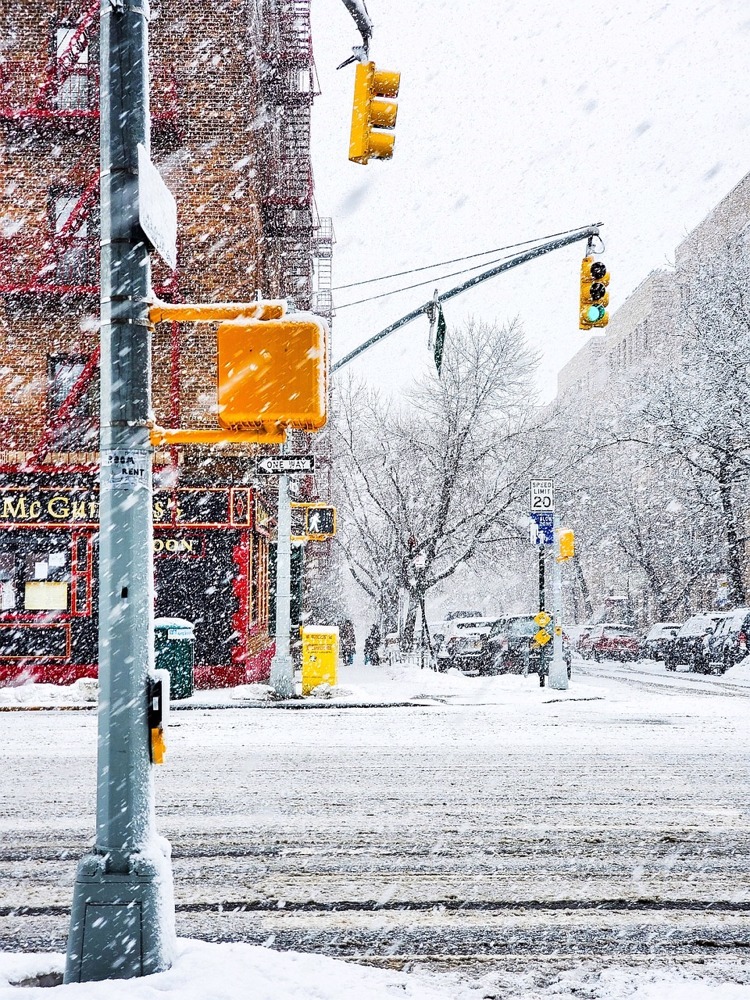Snowing in Winter
in New York
Home > New York State Photographs > New York > Snowing in Winter in New York

The first snowfall in New York came late in the evening, and with it a transformation of the city into a magical winter wonderland. The snow crested the fountains and lampposts, creating a surreal scene of twinkling white lights that glinted in the moonlight. Central Park became a white expanse of snow, where sledding, cross-country skiing, and ice skating abound.
The streets were filled with the sound of Christmas carols, and people were out ice-skating and sledding, their laughter ringing through the air. Everywhere, windows glowed with festive lights and decorations, and the fires in the fireplaces of quaint apartments blazed with warmth and cheer.
It was a time for family and friends to gather together and enjoy the season, and the city basked in the snow's ethereal beauty. As the night went on, the snow fell ever heavier, and the city was blanketed in an almost fairy-tale-like silence. Even the sounds of the bustling city were muted by the snow, and all that could be heard were the hushed murmurings of the people around them.
The snow seemed to bring out the best of the city, and as the morning sun rose, the view of New York in its wintery glory was breathtaking.
Snowfall in New York
Snowfall in New York, particularly in New York City, is a familiar and iconic winter phenomenon. The state experiences a range of weather conditions due to its varied geography and latitude, but snowfall is a common occurrence during the winter months. Here's an explanation of what snowing in New York entails:
Winter Weather Patterns
New York's climate is influenced by its position on the northeastern coast of the United States. During the winter, cold air masses from the north and west meet with moist air from the Atlantic Ocean, leading to the formation of snowfall under the right conditions.
Snowfall Timing
Snowfall in New York typically occurs from late fall through early spring, with the most significant snow events usually happening between December and February. However, light snowfalls can occur in November and March as well.
Snow Accumulation
The amount of snow accumulation can vary widely from year to year and within the state itself. In New York City, for example, the urban heat island effect can lead to slightly less snow accumulation compared to the surrounding suburbs and upstate areas.
Impacts on Daily Life
Snowfall can have significant impacts on daily life in New York. It often leads to the closure or delay of schools, disruptions in public transportation (such as buses and trains), and difficulties for commuters. Snow removal efforts are extensive, involving plowing streets, salting roads, and clearing sidewalks.
Aesthetics and Tourism
Snow-covered landscapes can create picturesque scenes, enhancing the aesthetic appeal of iconic landmarks like Central Park, Times Square, and the Brooklyn Bridge. Snowfall also contributes to the holiday atmosphere in the city and attracts tourists looking to experience a "White Christmas" in New York.
Winter Activities
Snowfall offers opportunities for various winter activities. In upstate New York and the surrounding areas, there are ski resorts and winter sports destinations that benefit from consistent snowfall. In New York City, residents and visitors can enjoy activities like ice skating in Central Park or at the Rockefeller Center.
Climate Change Impact
Over the years, New York, like many other places around the world, has experienced shifts in weather patterns due to climate change. While snowfall remains a characteristic of the winter season, variations in intensity, timing, and frequency of snow events can occur as a result of changing climate patterns.
In summary, snowfall in New York is a regular occurrence during the winter months, especially between December and February. It affects daily life, adds to the city's visual charm, supports winter tourism, and offers recreational opportunities. However, it's important to note that snowfall patterns can be influenced by broader climate trends.


